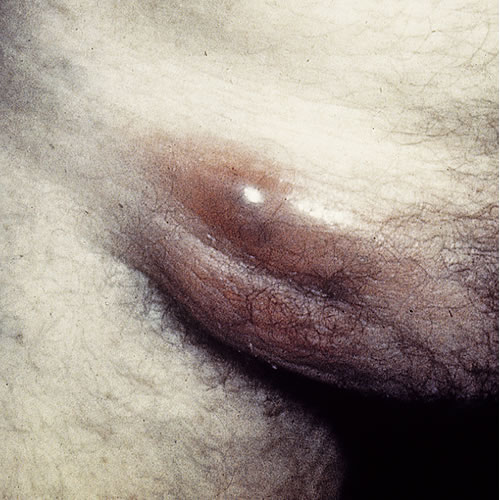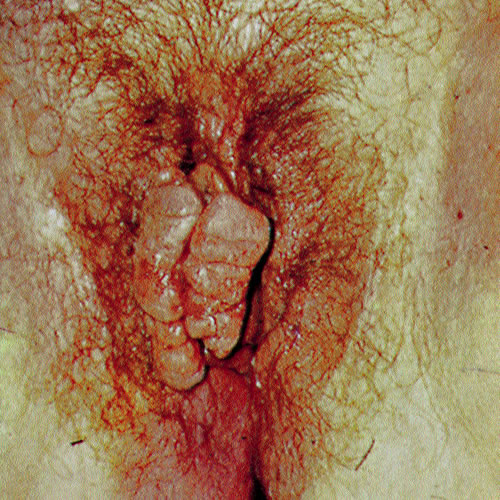Introduction
A rare sexually transmitted disease, lymphogranuloma venereum (LGV)1 results in regional lymphadenitis, fistulas, and strictures. The synonym for LGV is lymphogranuloma inguinale.
Epidemiology
Usually occurring between the ages of 20 and 50 years, it is most commonly found in Africa, India, some parts of Asia, and the Caribbean.
Etiology
Lymphogranuloma venereum (LGV)2 is caused by L-serovars of Chlamydia trachomatis, immunotypes L1, L2, and L3.
Symptoms and clinical features
- A history of sexual exposure to an infectious partner from an endemic area may be elicited. Incubation period to the first stage is three to 30 days.3 The most common clinical manifestation of LGV among heterosexuals is tender inguinal and/or femoral lymphadenopathy that is typically unilateral. Rectal exposure… can result in proctocolitis, including mucoid and/or hemorrhagic rectal discharge, anal pain, constipation, fever, and/or tenesmus.4
Symptoms vary by stage:
- First Stage: There is a small, relatively painless ulcer or abrasion in the genital area that may go unnoticed. On exam, there is a small erosion or ulcer or even a group of ulcers like herpes simplex around the clitoris, vulvar introitus, anus or sometimes on the vaginal wall. There may be a mucopurulent cervical discharge.
- Second Stage: Occurs about one to four weeks later; these patients go on to develop a cervicitis and salpingitis with tender inguinal lymphadenopathy accompanied by fever, malaise, headache, arthralgia, and nausea. There may be severe lower abdominal and pelvic pain.
The lymphadenopathy is the main feature of this disease, and the enlarged nodes are often peri-rectal in women, as opposed to inguinal in men (except for MSM having anal penetration.) They can break down, creating rectovaginal and anal fistulas, giving gastrointestinal symptoms rather than genital ones. This is referred to as the anogenitorectal syndrome. In the inguinal area, the enlarged buboes can cause an inflammatory mass of lymph nodes separated by a depression or groove made by Poupart’s ligament, giving the typical “groove” sign.
- Third Stage: The resulting chronic edema and scarring can cause discomfort, dyspareunia, and so forth. Chronic genital edema results from long-standing lymphatic inflammation and scarring, yielding vulvar elephantiasis.

Fistulae and abscesses may be difficult to manage.
Diagnosis
Diagnosis is based on clinical suspicion, epidemiologic information, and the exclusion of other etiologies for proctocolitis, inguinal lymphadenopathy, or genital or rectal ulcers. C. trachomatis testing should be conducted, if available.5 Serologic test interpretation for LGV is not standardized, tests have not been validated for clinical proctitis presentations, and C. trachomatis serovar-specific serologic tests are not widely available. In the absence of specific LGV diagnostic testing, patients with a clinical syndrome consistent with LGV, including proctocolitis or genital ulcer disease with lymphadenopathy, should be treated for LGV as described in the CDC report.6
Pathology/Laboratory Findings
A complement-fixation test demonstrates a titer of greater than 1:64 in active disease (Chlamydia serology). A microimmuno-fluorescence test demonstrates a rising titer, which generally supports the diagnosis.
Differential diagnosis
- First Stage: Primary syphilis, chancroid, and genital herpes.
- Second Stage: Genital herpes, syphilis, bacterial infections, chancroid, and Hodgkin’s disease. In the anogenitorectal syndrome, differentiate it from ulcerative colitis, Crohn disease, and so forth.
- Third Stage: Chronic edema associated with Crohn disease, lymphedema from chronic infection and lymphatic drainage,
It is important to diagnose early to avoid scarring and chronic lymphedema.
Treatment
Treatment cures infection and prevents ongoing tissue damage, although tissue reaction to the infection can result in scarring. Buboes might require aspiration through intact skin or incision and drainage to prevent the formation of inguinal/femoral ulcerations. Doxycycline is the preferred treatment.7
- Doxycycline 100 mg orally 2 x a day x 21 days
OR - Erythromycin 500 mg orally 4 x a day x 21 days
During the third stage, surgical management may be necessary.
References
- Fisher BK, Margesson, LJ. Genital Skin Disorders: Diagnosis and Treatment. Mosby, Inc., 1998. 146
- Fisher BK, Margesson, LJ. Genital Skin Disorders: Diagnosis and Treatment. Mosby, Inc., 1998. 146.
- CDC STD Treatment Guidelines, 2010
- CDC STD Treatment Guidelines, 2010
- CDC STD Treatment Guidelines, 2010
- CDC STD Treatment Guidelines, 2010
- CDC STD Treatment Guidelines, 2010